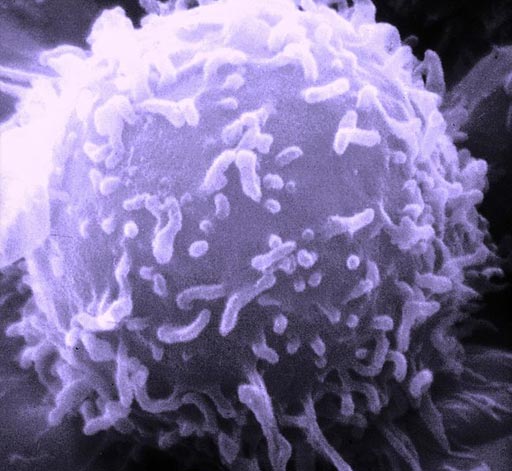Checklist Developed for Early Identification of Infants with SCID
By LabMedica International staff writers
Posted on 26 Sep 2017
Poor recognition of severe combined immune deficiency (SCID) syndrome by front-line doctors is leading to delays in diagnosis. A new testing regime aims to make diagnosis faster so that more infants with SCID, a “bubble-baby disease”, can receive life-saving treatment in time.Posted on 26 Sep 2017
Babies born with SCID are highly vulnerable – defenseless against bacterial and viral infections that would be essentially harmless to most healthy people. Many will repeatedly visit doctors with serious and recurring infections before being diagnosed. For the best chance of survival, infants should be treated within age 3.5 months.

Image: A scanning electron microscope (SEM) image of a single human lymphocyte (Photo courtesy of the National Cancer Institute).
A study, led by researchers at the University of Hong Kong (Hong Kong), has resulted in the new testing regime that could lead to initiating treatment within the critical timeframe. They developed a checklist of 4 potential SCID markers: family history of early infant death; persistent candidiasis (often presenting as persistent thrush); Bacillus Calmette-Guérin (BCG) infections; and low absolute lymphocyte counts. "Flagging" an infant showing any one of these factors would allow potential SCID patients to be fast-tracked for further tests and treatment.
Many countries do not test for SCID in their newborn health-screening programs, with front-line doctors often left to diagnose the condition. By using this checklist, the authors suggest that diagnosis will often be possible much sooner.
"The recognition of SCID by doctors is poor in Asia, resulting in delayed diagnoses that jeopardize the chance of treatment success," said lead researcher Yu Lung Lau, professor at U. Hong Hong, "We wanted to see if we could identify any clinical features that would help doctors to diagnose SCID earlier."
The study of 147 patients examined how long it took for doctors to diagnose SCID, relative to the age the babies were first brought to their doctors, and what symptoms they had. It took an average of 2 months for babies to be diagnosed, and the average age at diagnosis was 4 months – beyond the critical age for treatment (usually stem cell transplants or gene therapy) to begin.
Upon examining the data, the 4 SCID indicators emerged. Taken in isolation, none helped reduce the time taken for a diagnosis. However, 94% of the patients studied showed at least 1 of the 4 factors.
Family history of early infant death correlated with earlier age at diagnosis but not shorter time to diagnosis. "Family history of early infant death due to infection was useful to aid earlier diagnosis, but it was not due to doctors realizing the importance of the family history, but rather due to the family taking the child to see the doctors earlier," said Prof. Lau, "This demonstrates the failure of our medical training and systems in using family history to aid earlier SCID diagnosis."
Candidiasis emerged as one of the most common infections. Unfortunately, as thrush is relatively common in all infants, its presence actually slowed down the time to diagnosis.
Complications from the BCG vaccination also appeared frequently, and over 88% of the patients in the study had a very low absolute lymphocyte counts (ALC). "Our main recommendation is to perform lymphocyte subsets for any infant with one or more of the following clinical features: family history, persistent candidiasis, BCG infections, and ALC less than 3x10^9/L", said Prof. Lau.
For the time being, newborn screening remains out of reach in much of Asia, so education of front-line doctors and parents is key. These recommendations “need to be communicated to doctors as well as to ordinary citizens, who can then urge the doctors along our recommendation," said Prof. Lau.
The study, by Luk ADW et al, was published July 12, 2017, in the journal Frontiers in Immunology.
Related Links:
University of Hong Kong













